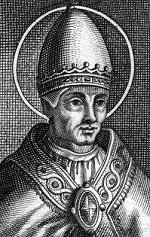
Felix III Descendant of aristocrats and the son of a priest, St. Felix III was a widower with two children when he was elected to the papacy in 483. He was the first pope to announce his election to the emperor in Constantinople. The following year, he excommunicated Patriarch Acacius of Constantinople, who was a monothelite. A synod in 485 confirmed the pope's decision and action. Felix addressed the issue of readmitting to the church those whom Arians had forcibly rebaptized: lay people were allowed back after penance, and clergy were allowed back only on their deathbed. Felix died in 492.
Pope Felix III (died 1 March 492) was the bishop of Rome from 13 March 483 to his death. His repudiation of the Henotikon is considered the beginning of the Acacian schism. He is commemorated on March 1.
Family
Felix was born into a Roman senatorial family - possibly the son of a priest. He was married and widowed before he was elected as pope. He fathered two children, and through his son Gordianus (a priest) was thought to be great-great-grandfather to Pope Gregory I, and possibly related to Pope Agapetus I.
It was also said that Felix appeared as an apparition to another of his descendants, his great-granddaughter Trasilla (an aunt of Pope Gregory I), and asked her to enter Heaven, and "on the eve of Christmas Trasilla died, seeing Jesus Christ beckoning".
Eutychian heresy
Eutyches was an archimandrite at Constantinople. In his opposition to Nestorianism he seemed to have taken the opposite view to extremes. In an effort to diffuse controversy regarding the teachings of Eutyches, in 482 Emperor Zeno, at the suggestion of Patriarch Acacius of Constantinople, had issued an edict known as the Henoticon. The edict was intended as a bond of reconciliation between Catholics and Eutychians, but it caused greater conflicts than ever, and split the Church of the East into three or four parties. The Henotikon endorsed the condemnations of Eutyches and Nestorius made at Chalcedon and explicitly approved the twelve anathemas of Cyril of Alexandria, but in attempting to appease both sides of the dispute, avoided any definitive statement on whether Christ had one or two natures.
Felix's first act was to repudiate the Henoticon. He also addressed a letter of remonstrance to Acacius, Bishop of Constantinople. The latter proved refractory and sentence of deposition was passed against Acacius.
As the Catholics spurned the edict, the emperor had driven the patriarchs of Antioch and Alexandria from their sees. Peter the Tanner, had intruded himself into the See of Antioch, and Peter Mongus, had seized that of Alexandria. In his first synod, Felix excommunicated Peter the Fuller, who had deposed Martyrius of Antioch and assumed his See in 470. In 484, Felix also excommunicated Peter Mongus, who had taken the See of Alexandria, an act that brought about a schism between East and West that was not healed until 519.
Aftermath of the Vandals
In Arian Africa the Vandal persecutions of Genseric and his son Huneric had driven many Catholics into exile. Huneric was a fervent adherent to Arianism. When peace was restored, numbers of those who through fear had fallen into heresy and had been rebaptized by the Arians desired to return to the Church. On being repulsed by those who had remained firm, they appealed to Felix who convened a synod in 487, and sent a letter to the bishops of Africa, expounding the conditions under which they were to be received back.

